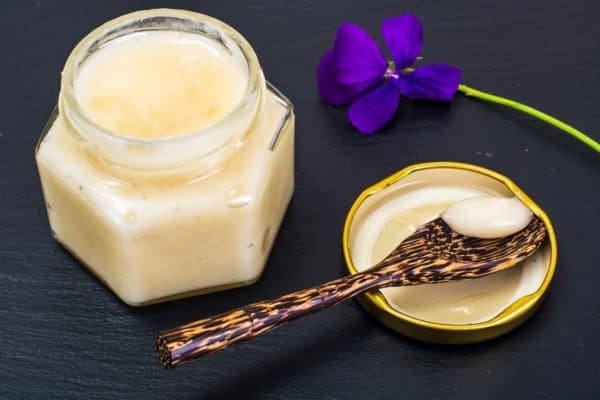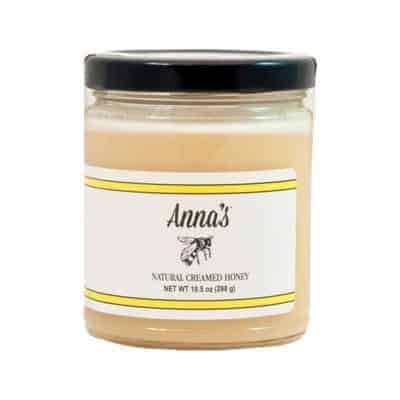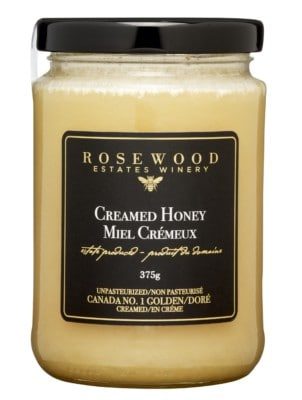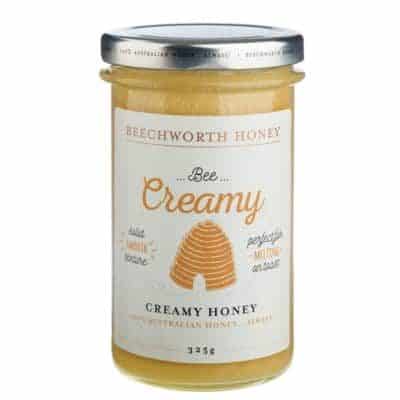Considered a piece de resistance in the world of raw honey, creamed honey is an exceptional bee product with a mouthwatering texture and powerful nutritional profile.
Also referred to as churned honey, spun honey, whipped honey, or honey butter, this product is neither creamed nor whipped, despite the misnomers.

So what exactly is creamed honey?
Creamed honey is honey that’s crystallized in a controlled process. A creamed honey culture is stirred through liquid honey resulting in fine, uniform sugar crystals. This process prevents large granules from forming, creating a thick, creamy, spreadable consistency. Creamed honey is light in color, tastes sweeter, and feels pleasant on the tongue, unlike normal crystallized honey.
It is a perfect way to store honey since it does not go back to natural crystallization, and it retains consistency. Its taste is also hypnotizing.
Read on to find out how you can make creamed honey at home, how to incorporate it into your foods, the health benefits, and much more.
Why Does Raw Honey Crystallize And What Affects The Process?
Honey is an exceptionally concentrated sugar solution, with more than 70% sugar and less than 20% water content. Therefore, it is only logical for honey to crystallize since it is over-saturated with sugars. Unlike fructose, glucose takes shape since it is less soluble in water. Different types of honey crystallize at varying rates.
Honey contains two types of sugars: fructose and glucose. During harvesting, it is collected in liquid form. When liquid honey is left in a container, it eventually crystallizes although it does not spoil. These granules make it look unappealing and sugary. Most people associate granulated honey with low quality and adulteration.
However, crystallization is a normal process of honey. How is this rectified? Most manufacturers cream honey to prevent crystallization.
Here are some factors that can influence the process:
Glucose Levels
As aforementioned, glucose is the type of sugar that granulates in honey. Various types of honey from different sources have different levels of glucose depending on the flower type and nectar. Some flowers such as clover, dandelion, mustard, and cotton have a higher ratio of glucose hence crystalizing more quickly.
Presence Of Catalysts
These catalysts include particles of pollen, beeswax, seed crystals, propolis, and so on, which are present in raw, unfiltered honey. These particles create a surface or nuclei for crystals to start forming. Their presence speeds up the granulation process. Eliminating foreign particles from raw honey through filtration delays crystallization.
Temperature
Honey placed in the fridge will crystallize faster. On the other hand, high temperatures above 40 degrees Centigrade cause crystals to dissolve. They also destroy the properties of creamed honey.
Do You Make Or Buy Creamed Honey?
Even though, on the pricier side, most people prefer creamed honey to standard honey. While you can easily find whipped honey in food stores, making it in the comfort of your home, it’s rather easy and cheap. Many parents prefer creamed honey since its thickness prevents spills in the kitchen.
Composition and Nutrition Content of Creamed Honey
Whipped honey is 100%, pure natural honey and it does not contain any dairy and has nothing added to it. Pasteurized and high-pressure filtered honey do not crystallize too, even if the heating process rips off the healthy enzymes.
It has the same nutritional value as liquid honey. The biologically active consistency, all compounds, great taste, and aroma remain the same after the whipping process. You enjoy the benefits of raw honey, which includes vitamins, minerals, proteins, essential oils, and antioxidants.
How To Use Creamed Honey
Whipped honey is sweet and versatile in recipes. It is very consistent if you want to eat honey with a spoon. It is easy to scoop and spread. No sticky drips on tables, floors, or counters.
Here are various ways to use it.
Sweetener
Creamed honey can be used to sweeten tea, coffee, and other drinks. You can also add it to juices.
Spread
It makes an excellent spread on toast, rolls on top of butter, bread, biscuits, and sandwich. It is thicker and does not drip from the knife, like regular honey.
Baking
It can also be used in baking as a sweetener. Products baked with creamed honey have a unique sweetness that tastes great. It outdoes other sweeteners.
Breakfast Cereals
Creamed honey can be mixed with breakfast cereals such as oatmeal.
Snacks
You can also apply churned honey on sliced pears, apples, cheese, and hot sweet potatoes.
Making Pancakes
Creamed honey can be used as an alternative to sugar or syrup while making pancakes.
On Toast
Creamed honey is a gourmet easy to spread delicacy for the humble piece of toast.

Creamed Honey Infusions
While the taste of the plain churned honey is pleasant, you can also make creamed honey blends, which give a burst of flavors. It can be blended with cinnamon, ginger, cardamom, clove, peppercorn, or vanilla beans while maintaining its natural state. Amazingly most people do not go back to regular honey after tasting the whipped honey.
Health Benefits Of Creamed Honey Over Normal Honey
Raw creamed honey retains all the original proportions of vitamins, minerals, and enzymes. Although, this depends on how the cream honey is made.
Commercial creaming may involve ultra-filtration and pasteurization. On the other hand, the production of regular honey involves pasteurization and filtration before bottling.
Regular honey may also contain additives and sugars such as corn syrup. Surprisingly, most honey found on supermarket shelves is not raw honey but pasteurized honey. Even though it remains liquid over a long period, once the honey is heated, most nutritional benefits are likely to be destroyed.
Here are some of the benefits of raw churned honey.
Creamed honey is an antioxidant powerhouse. The antioxidants protect the body from cell damage caused by free radicals, which cause premature aging and also contribute to chronic conditions such as heart disease and cancer. While regular honey contains a reduced amount of antioxidants, creamed honey is packed with them.
It soothes the pain caused by a sore throat and calms cough due to viral infections and acid reflux.
It soothes the heartburn pain and the burning sensation caused by gastric juice regurgitation.
It promotes skin health by providing a gentle exfoliant, moisturizer and also helps in regulating sebum production.
Raw honey has probiotic properties that promote digestive health. It raises sugar levels, which makes it an ideal food for people with hypoglycemia.
Bee pollen present in raw honey has anti-inflammatory, antifungal, and antibacterial properties. It eases the symptoms of menopause, such as hot flushes. It also strengthens the immune system, helps the body to avoid illnesses, and can be used as a dietary supplement.
Bees Propolis is rich in flavonoids such as pinocembrin, which has antimicrobial properties. It aids wound healing by speeding up the growth of new cells.
It also contains B vitamins, C and E, beneficial enzymes, magnesium, and potassium.
How Is Creamed Honey Made?
Creamed honey is made by adding crystallized honey to liquid honey and then spinning the mixture. The more you churn it, the creamier, silkier, and smoother it becomes.
The color of honey also changes from dark to pale. The mixture is then stored at a low temperature to form a firm texture. No emulsifiers are used to harden the creamed honey.
Where Do You Buy Creamed Honey?
You should buy creamed honey from a reputable producer. Some producers make churned honey at high temperatures or mix it with sugar and low-quality honey and sell it at a premium price. It is good to know the source of churned honey and how it has been made.
Looking for more different and interesting honey varieties? We have done a ton of research for you. If you are interested the article is called, Honey Varieties You Should Discover.
How To Make Creamed Honey At Home?
Making creamed honey is a relatively simple process. You can make it in the comfort of your home anytime.
Here is what you are going to need:
Ingredients
- Seed honey
- Liquid honey or stock honey
- Optional; flavors such as cinnamon, vanilla.
Equipment
- A medium saucepan with a lid
- A sterilized jar with a lid
- A wooden spoon
- A candy thermometer
Step By Step Process
Select The Seed Honey
Use honey that has already been creamed so that it promotes more crystallization in the fresh liquid honey. It can be purchased in grocery stores, farmer’s markets, or health food stores.
It is sometimes labeled as whipped, set, or spun honey. It is crucial to use a starter with the attributes that you desire on your end product.
You can also use crystallized honey powder as a seed. You can get the powder by grinding crystals of unprocessed honey, which has granulated naturally.
Prepare Your Liquid Honey
You need to ensure that your stock honey is free from naturally occurring crystals. Honey fresh from the comb is fine. If you notice any crystals in the honey, you will need to heat it for the crystals to melt.
An ideal way to do this is by placing the jar with liquid honey in a pot of hot water (100 degrees F) until it is runny. Although you achieve your goals faster with hot water, lower temperatures are better as they preserve the nutrients and minerals. Ensure the honey cools to room temperature before you proceed.
Add The Starter
Add about 10% creamed honey or powdered crystallized honey to your stock honey and blend well. Stir gently for about 3 minutes until the seed is fully incorporated in the liquid honey. At this point, you can add any other ingredients for the desired flavor.
Chill The Creamed Honey
Pour the mixture into preferred sterilized containers and seal. Flat plastic containers or jars with a wide mouth are perfect since you will need to use a spoon to scoop it out. Transfer it to a cool place (14 degrees Centigrade ) and let it rest for a week or so that it can crystallize and turn to creamed honey.
Enjoy
You will be able to see when the creaming process is over. The honey will be firm and will not flow when tipped over. Store it at room temperature in a cupboard or a pantry.
Are you interested in making another type of honey at home? Check out this article on Black Seed Honey.
What Happens When Stock Honey Is Not Fully De-crystallized Before Creaming?
If you use stock honey with some natural crystals, you will be left with a mixture of small and large crystals. The large crystals will revert your creamed honey into set honey. They will prevent you from obtaining the creamy texture that you want.
How To Store Creamed Honey
Refrigerating creamed honey is not required. It remains stable and consistent at room temperature. However, in warmer climates refrigerating your whipped honey retains its properties. Excessive heat makes it liquefy and return to its liquid state.
To return to its solid creamy state, place the honey in a fridge for a few days until it becomes solid. For ideal storage, keep your creamed honey in a cool place.
Why Is Creamed Honey White In Color?
Creamed honey is lighter than liquid honey. This is because the glucose that crystallizes reflects light in a different way, which makes it appear whiter to the eyes. Likewise, liquid honey that is granulated appears lighter than de-crystallized liquid honey.
If Creamed Honey And Liquid Honey Have The Same Contents, How Are They Different?
Liquid and creamed honey only differ in texture and thickness. Once the honey has been creamed, it is soft and creamy. Whipped honey does not drip like liquid honey, but is smooth, spreadable, and similar to butter. Unlike liquid honey that can crystallize into a hard block, creamed honey cannot do that because it is already granulated.
Where Can You Buy Creamed Honey And How Much Does It Cost?
You will be surprised to realize that the honey on the supermarket shelves and in your favorite food stores is not raw honey.
How do we know this? -Well, raw honey is most likely to crystallize, whereas commercial honey has undergone pasteurization and ultrafiltration to keep it in liquid form for a long period.
Creamed honey is one of the exceptional bee products at your disposal. It has gained popularity in recent years. Although it may cost more than regular honey there are innumerable benefits to enjoy.
The price of a pound of creamed honey (0.45kg) ranges from $5 to $16. Here are links to some of the sites that sell creamed honey.
The Wrap Up
Creamed honey does not do well in low-latitude countries. The warm climate in places like Singapore causes it to be unstable and turns to liquid honey over time.
Secondly, too much moisture on the creamed honey makes it ferment. It is best made with a moisture content of 16.5-17.5%. You need to be extra careful especially when adding flavors to the creamed honey since they can raise the water content.
It is advisable to refrain from adding fruit juices or oils. Lastly, commercially produced churned honey is likely to undergo pasteurization, which destroys beneficial elements.
Maybe you’re like us and enjoy tasting honey from different origins and regions or maybe you’re just realizing that there is more to honey than what you see on the supermarket shelves.
We have done the research for you on a whole range of varieties of honey for you. Below is a list of different types of honey from different floral origins and regions. If you are interested check them out, Honey Varieties You Should Discover.
Sources
https://amberdrophoney.com.au/what-is-creamed-honey/
https://www.mybeeline.co/en/p/what-is-creamed-honey-and-how-to-make-it



